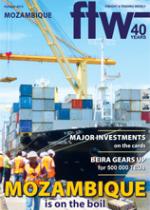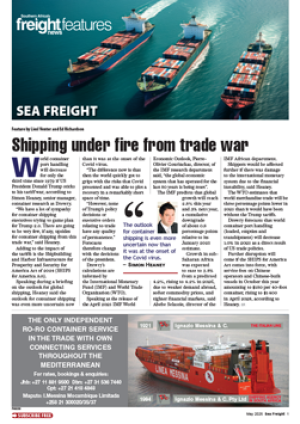A 65-hour turnaround
time for rail exports
of magnetite from
Phalaborwa to the
Matola terminal outside Maputo
is helping drive volumes ahead of
target, says Sarel Ceronio, chief
executive of Grindrod Terminals
Matola.
According to Grindrod chief
executive officer, Alan Olivier,
the company’s Maputo terminals
are expected to handle around
18million tons of cargo this year, up
from 15million tons last year, and
12million tons in 2011.
The original plan was to take the
port to 50million tons a year by
2025, but this can now be achieved
by 2020, Olivier said.
Grindrod operates Maputo
port in partnership with Dubai
Ports World and the Mozambique
Ports & Railways Company
(CFM) through the Sociedade
de Desenvolvimento do Porto de
Maputo (MPDC).
The MPDC was founded in
2003 and its shareholders are state
port and rail
company Portos
e Caminhos
de Ferro de
Moçambique
(CFM), with 49%
of the consortium
and South
Africa’s Grindrod
and Dubai Ports
World, with 51%.
Grindrod
operates the Matola Coal Terminal
which is run separately from the
port of Maputo.
According to Ceronio, the
growth through Matola comes
mainly from magnetite, which is a
form of iron ore.
Palabora Copper is exporting
roughly five million tons of
magnetite a year.
Ceronio says Grindrod worked
closely with the rail authorities
during a closure
of the rail link
following a
derailment on the
Ressano Garcia
line on February
18.
The fleet of
wagons used for
magnetite was
“ring fenced”
until the line
reopened on April 19.
“We have learnt from previous
experience that rail authorities
usually reallocate their wagons
when there is a major disruption,
and it is hard to get them back
when the line reopens. Transnet
Freight Rail maintained the fleet
size, which meant that shipments
could commence as soon as the line
opened,” he told FTW.
The Mozambican rail authorities
took advantage of the shut-down to
carry out maintenance on the line
and to upgrade the bridge, which was
damaged, to handle 26 tons per axle.
Work is under way on another
two bridges and the line itself to
bring the whole route up to the same
capacity.
Coal volumes have been affected
by a drop in world demand, but
the terminal is ready to handle any
growth in volumes.
In July, a “Phase 3.5” expansion
project was completed, bringing the
capacity to 7.3 million tons a year.
Feasibility studies for Phase 4 are
continuing.
INSERT & CAPTION
The growth through Matola
comes mainly
from magnetite.
– Sarel Ceronio

